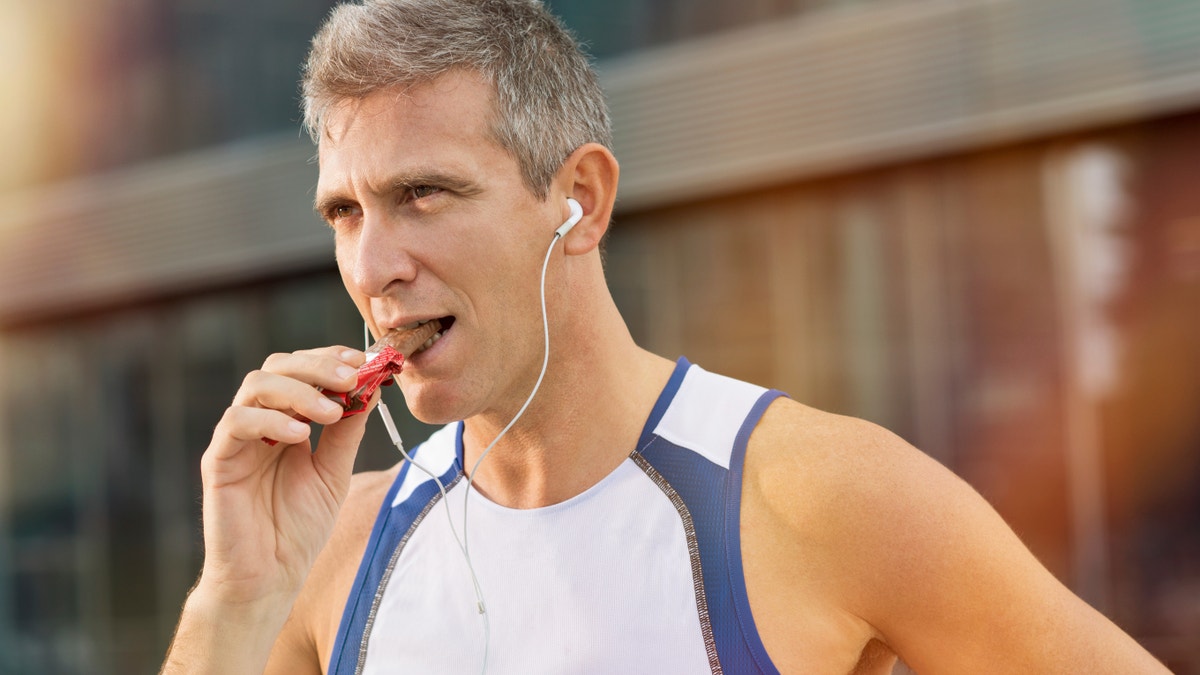
Portrait Of Fitness Mature Man Eating A Energy Bar Of Chocolate (iStock)
If you’ve been struggling to get some sleep, you’ve probably given your coffee habit a once-over. But if you’re still finding yourself in tired-but-wired mode even after cutting back on coffee, it may be time to look at what else you’re consuming.
That’s because you might be filling up on caffeine without even knowing it. A significant amount of caffeine can be found in non-coffee drinks, foods, and even pain relievers, said Donald Hensrud, MD, MPH, an associate professor of nutrition and preventive medicine at the Mayo Clinic.
And that adds up quickly: You can easily exceed the recommended daily amount of caffeine — 400 milligrams (mg) a day, according to the Food and Drug Administration — even if you don’t drink coffee.
Related: You must read this if you drink more than 4 cups of coffee a day
Think caffeine might be causing your sleepless nights? Read on to learn some surprising sources of it that might be messing with your shuteye.
Surprising caffeine culprit: Orange soda
No, it’s not just cola that packed with caffeine. Sunkist actually beats Coke when it comes to caffeine content: One 12-ounce can of the orange stuff includes 41 mg of caffeine. Compare that to Coke, which has just 34 mg in the same size can.
Related: Can soda give you Alzheimer’s disease?
Surprising caffeine culprit: Flavored almonds
Sure, if the flavor is coffee or chocolate, it’s only reasonable that the food will contain some caffeine. But Blue Diamond really plays up the jolt in their Oven Roasted Café Mocha Almonds. Each ounce of the nuts clock in at 24 mg of caffeine.
Related: 6 reasons to eat a handful of nuts every day
Surprising caffeine culprit: Pain relievers
Caffeine helps pain medications work better — particularly for headaches — because it increases dopamine production while also blocking pain signals in the brain, says Hensrud. That’s why some pain relievers include caffeine as an ingredient. For instance, Excedrin Migraine has 130 mg of caffeine, Bayer Back & Body has 65 mg, and Anacin has 64 mg.
Surprising caffeine culprit: Protein bars
Again, any flavor with chocolate will have some caffeine, but the amount may be more than you’d expect in one little bar. For instance, Clif Bar’s Cool Mint Chocolate has 49 mg per bar — more than a 12-ounce can of Coke.
But other non-chocolate flavors might, too. Clif’s peanut toffee buzz also has 49 mg, thanks to artificially added caffeine.
Related: The 12 best protein bars for men
Hard part is, you might not be able to find out if your bar is packing: Not all manufacturers list caffeine on their labels — it’s missing from brands like Gatorade and PowerBar, even in their chocolate-based flavors.
Surprising caffeine culprit: Fancy water
If water claims to boost your energy, chances are it’s doing it by flooding you with caffeine. In fact, some energy waters boast about their caffeine content. Vitamin Water has 50 mg in a 20-ounce bottle, and Avitae has 45 to 90 mg in a 16.9-ounce bottles, depending on flavor.
Many are getting an additional buzz from guaraná, a Brazilian plant with double the caffeine content of coffee beans — and the amount from the plant isn’t always included in the caffeine content on the label.
The bottom line on caffeine
All of these sources can add up quickly. For example, if you had two tall cups of Starbucks Blonde roast in the morning, 3 ounces of Blue Diamond almonds with a Vitamin Water in the afternoon, a Clif Bar before working out, and a couple of Excedrin for a headache, you’d be at 841 mg for the day — over double the recommended amount.
Too much caffeine doesn’t just leave you uncomfortably buzzed, either. Side effects of overconsumption include heartburn, gastrointestinal upset, sleep problems, heart palpitations, decreased calcium and iron absorption, and urinary problems.
Related: Eat less of this so you won’t wake up to pee
It’s also possible you can feel jittery and gross even if you’re taking in less caffeine than the recommended 400 mg mark. That’s because your genes affect how you metabolize coffee, and some people may feel greater effects at smaller doses than others, Hensrud said.
